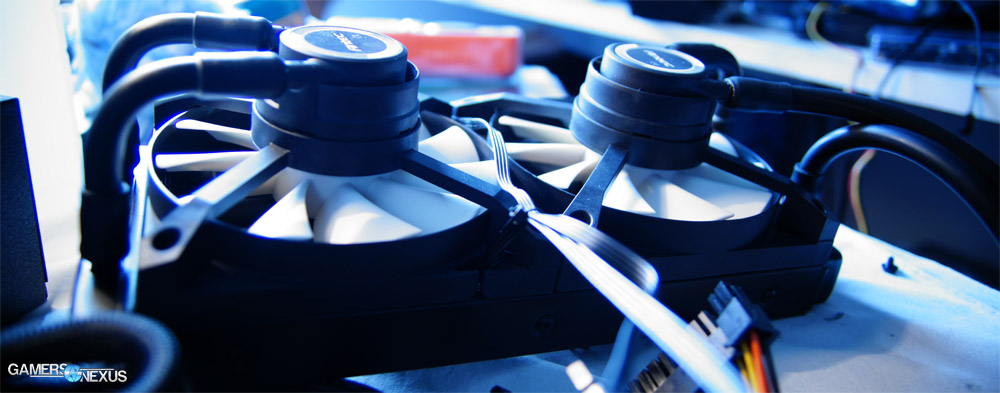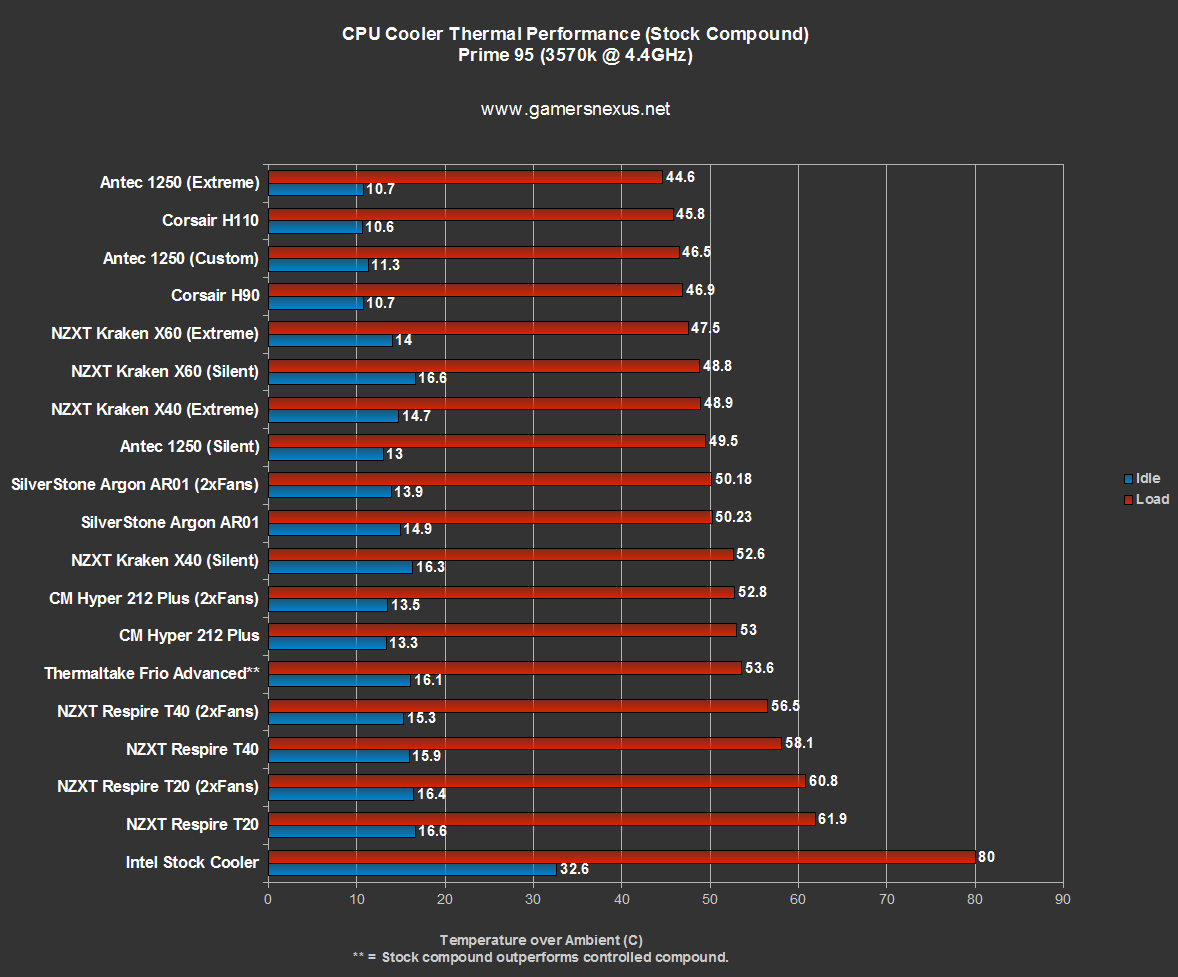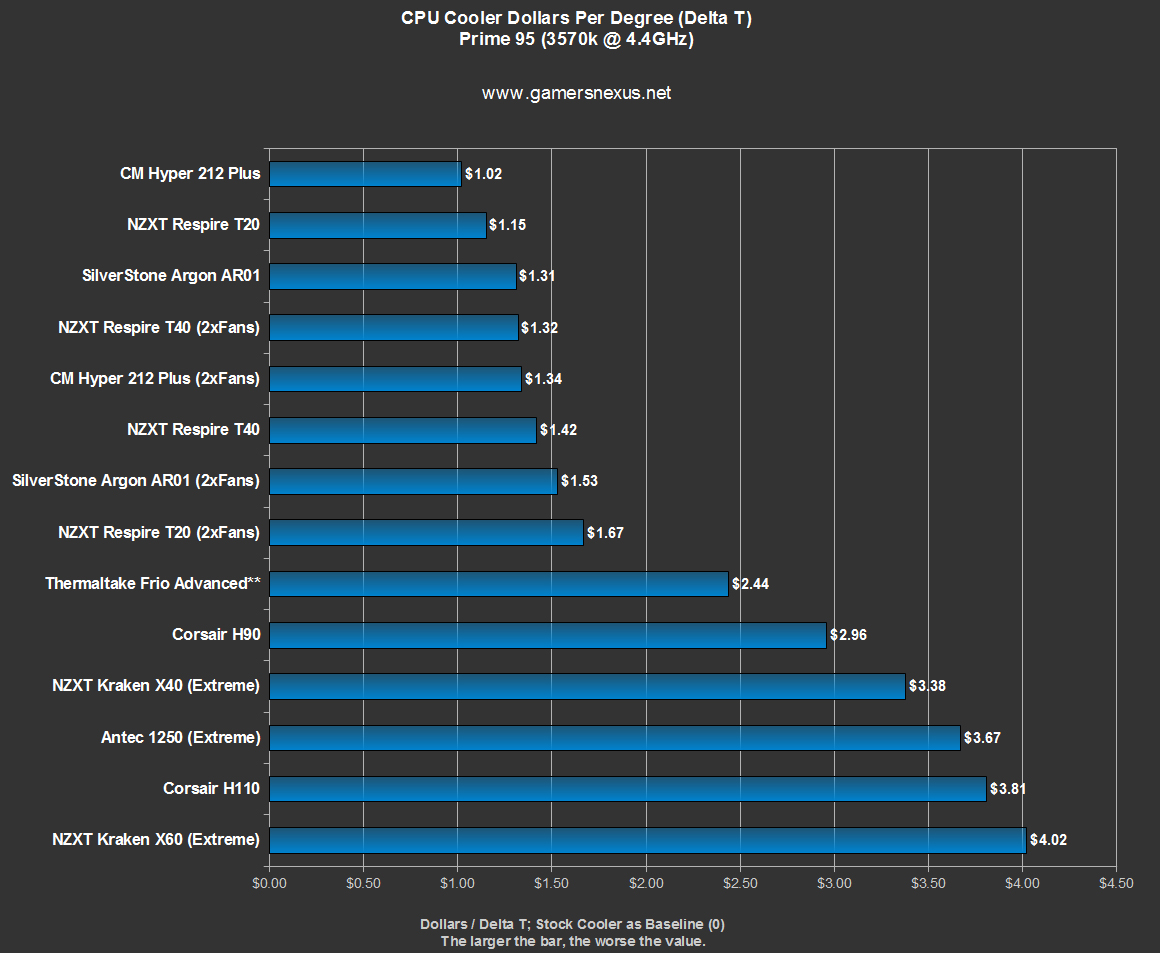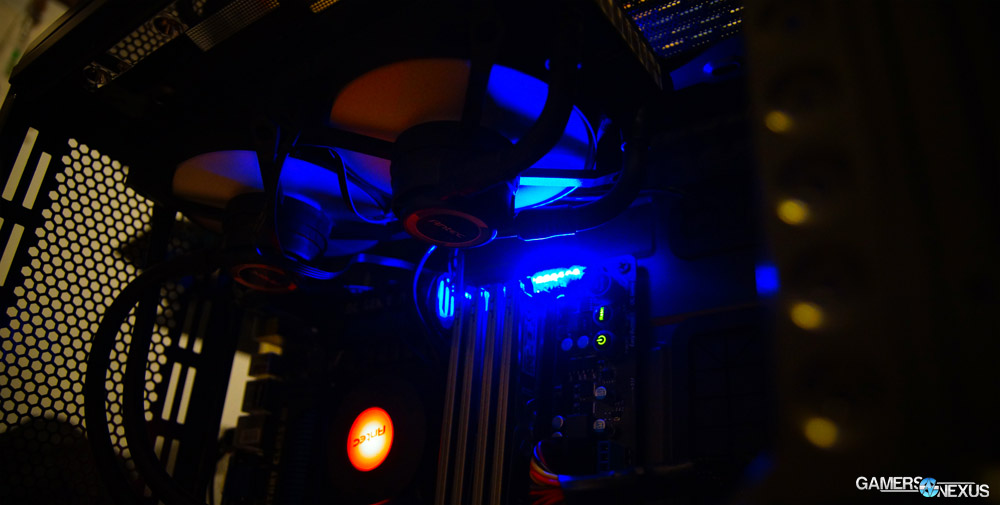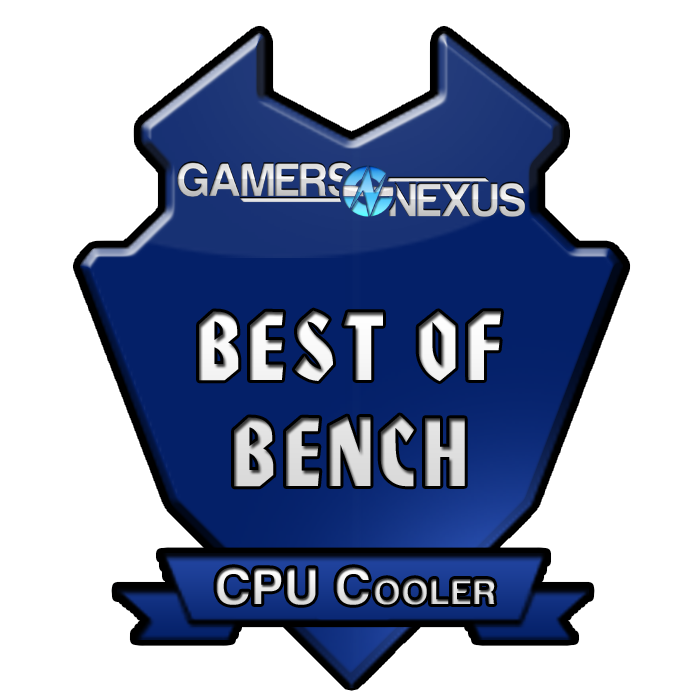Closed-loop liquid coolers first hit the market a few years ago, instantly becoming "the thing" to have; it was an easy solution for users who wanted to lay claim to liquid cooling, but didn't necessarily have funding / ability for an open loop system.
As these coolers emerged, it rapidly became evident that simply being a liquid cooler didn't make it inherently better than air. A solid, entry-level air cooler (like the AR01 or Hyper 212) will often out-endure and perform equally to a low-end liquid cooling solution. Just as with other aspects of hardware (a cheap Z87 board vs. an expensive H87 board, for instance), just because it's theoretically more advanced in one aspect, that doesn't mean the performance will outmatch a less technologically advanced product that employs higher-quality engineering. A tuned sleeper can blow past a high-end stock car, if we were to make analogous comparisons.
Antec's Kühler 1250 liquid cooler got me excited about CLCs again. Most of the CLCs on the market are all designed, built, and packaged by Asetek, who slap a Corsair or NZXT (and up until recently, Antec) sticker on it before shipping. Frankly, that's boring. The performance deltas are going to be limited to the fan and software, maybe some tweaking to radiator size, though that's rare. At that point, you're reviewing how fans interact with the same radiator, which is -- again -- boring. I did this for four coolers over here, where I explained the supply-side of the cooler industry. Antec's new 1250 was engineered entirely in-house and has 100% custom tooling, so it's a new product with a new approach to CLC design. Before jumping into the text, I'll leave you with my video explanation and product tear-down:
What's Inside a Liquid Cooler: CLC Tear-Down & Comparison - Antec 1250 vs. H110
In traditional CLC design (Asetek-supplied models included), the cooler is comprised of a few core parts (from the bottom-up):
Other than its computing application, this hasn't changed since the invention of liquid cooling. It's a very simple system. What Antec has done, though, is built it up like this:
The approach and design philosophy, at a top-level, is obviously the same. A radiator is a radiator. That's not news to anyone. The same for a pump. What's unique here is that Antec has applied a dual-pump design (this is found in open loop technology); two pumps working in unison will help spread load and enables faster transport of the liquid through the radiator. The end result, in theory, is cooler liquid throughout the entire system (it moves faster and is cooled faster), which results in better dissipation / whisking potential through the copper coldplate.
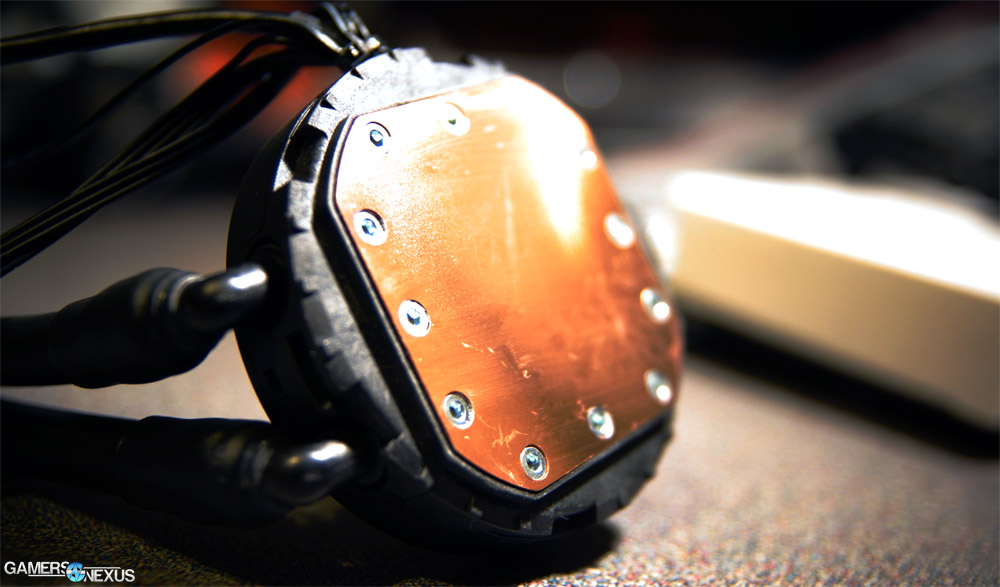 The bottom of the coldplate (before disassembly).
The bottom of the coldplate (before disassembly).
As with any cooler—air or otherwise—the copper plate is where the magic happens. Copper has a thermal conductivity of nearly 400W/mK, which blows aluminum (~200W/mK) out of the water. The interior of the CPU block is designed in a way that liquid whisks heat away from the copper plate by passing the liquid through tiny channels in the copper block. This design facilitates faster cooling of the copper plate and is used in all CLCs.
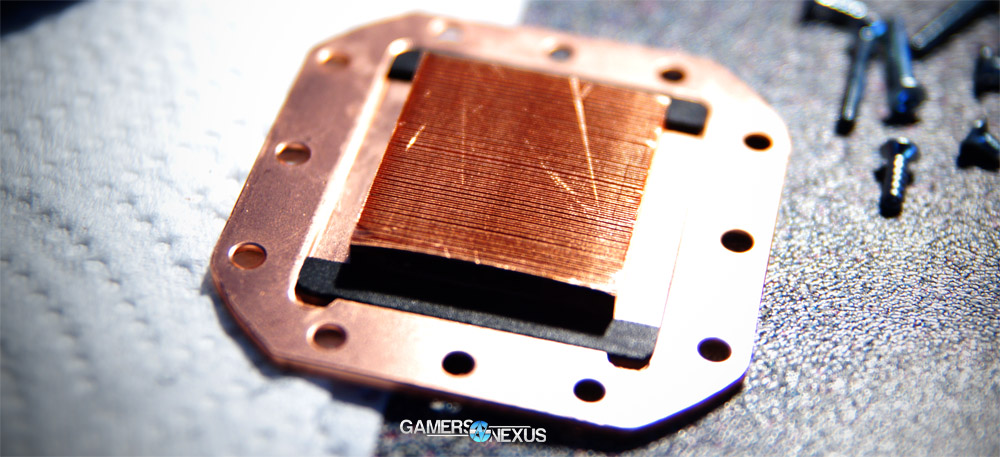 The inside of the coldplate (after disassembly); uses small copper channels to dissipate heat.
The inside of the coldplate (after disassembly); uses small copper channels to dissipate heat.
Mounting two large pumps atop the radiator does introduce several design complications and installation concerns, though. We'll get to those after a basic specs table.
In this Antec Kühler 1250 benchmark & review, we'll look at the new liquid cooler's performance, installation, specs, and tear-down to see how it works.
Antec Kuhler 1250 Specs - Closed-Loop Liquid Cooler
| Cooler / Rad Size | 240mm Cooler (280 x 120 x 27) |
| Pump & Fan Size | 120mm x 50mm height |
| Fan Spec | 600-3000RPM |
| Cold Plate | 26mm (1") |
| Tubing Length | 300mm (11.8") |
| Weight | 2.9 lbs. |
| Coolant | Anti-corrosive, Environmentally-friendly |
| Features | Temp-controlled LED Software for fan speed 3 speed settings Dual-pump design |
| MSRP | $120 (Currently on sale for $90) |
Antec Kühler 1250 Installation
I've given the 1250 some pretty high-praise so far -- and you'll see why in the benchmarks -- but not everything was perfect. To cut to the chase, I absolutely hated the installation process. Quite simply, the mounting bracket was frustrating and cumbersome; in talking with Antec, they seemed pretty sure of their mechanism, so perhaps I just need Gloves of Dexterity to install this cooler. Either way, I tried two different 1250s and grew frustrated and impatient while installing each.
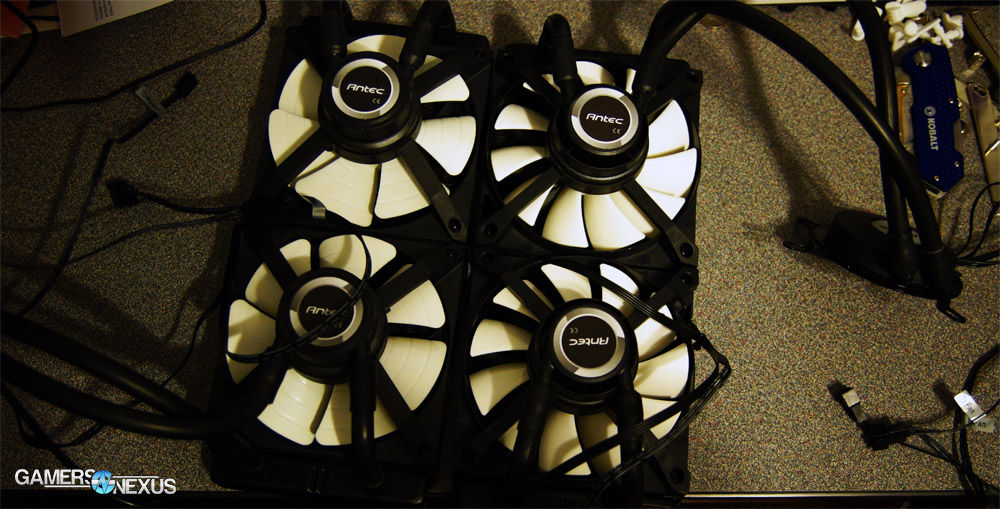 Left: Pre-production, larger / slower blades; Right: Finalized sample.
Left: Pre-production, larger / slower blades; Right: Finalized sample.
The thing is, the cooler bracket gives the appearance that it's not going to fit on some boards -- our test equipment is included in that. The chokes and caps flanking the socket on MSI G45 and GD65 boards will brush right up against the bottom of the mounting mechanism, so I found myself a bit concerned about placing unnecessary force on those components if the bracket were improperly designed. At the end of the day, everything worked out - it all fit together - but it took a few tries to be happy with it. It wasn't easy to orient the logo upward, either, and this is largely due to the same issue in combination with the extra tubing.
As for the mechanism itself, there are four sliders (each corner) on the circular plate that encases the CPU block. The sliders must be set to either AMD or Intel, but aren't as secure as I'd like them to be in their locking. These sliders move extraordinarily easily during installation, so you'll probably have to set them to the correct socket type a few times throughout the process. Honestly, I'd rather see Antec use a separate AMD and Intel bracket, rather than trying to cram them into the same unit. Or just develop a proper lock for the sliders. The backplate and its non-locking metal inserts didn't help matters, either.
During installation, you also need to be careful how the tubing and cabling are oriented -- the tubes will brush against nearby components if not properly positioned.
Having tested about two dozen coolers over the last year, I'm fairly certain that I'm not exceptionally incompetent when it comes to installing them. Most take me a few minutes, but the 1250 desperately needs a new mounting bracket. It may work at the end of the day, but that doesn't mean it can't be improved. And it should be. If I were an end user, I would have returned the product without ever installing it -- it was just cutting it too close to critical board components to feel comfortable.
Antec Kühler 1250 Build Quality
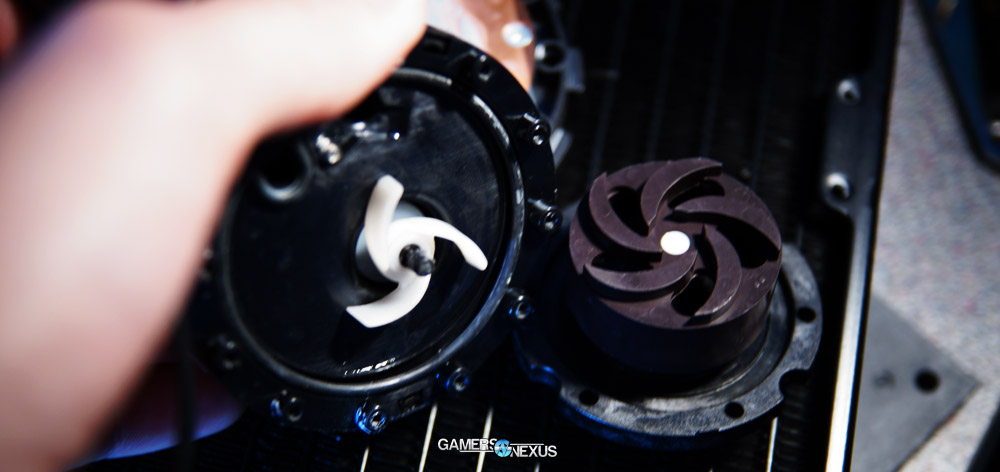 Left: Asetek plastic pump (Corsair H110); Right: Antec metal pump.
Left: Asetek plastic pump (Corsair H110); Right: Antec metal pump.
All the complaining aside, the overall build quality is solid; the radiator is, well, a radiator, the pumps are stable and silent (they lack the annoying whirr that other pumps exhibit), and the fans don't cause any rattling or vibration within the case. The copper coldplate is from a common supply and uses standard design, but is high-quality nonetheless.
Antec has opted to use the rubberized tubes, which all nearly all manufacturers have switched over to; several years ago at a tradeshow, Corsair privately knocked the rubber tubing solution, stating that their plastic / bendy tubes were far superior to "nearby competitors." Since telling us this at the show, Corsair has also switched to rubber tubing and has retained its warranty policy, so I suppose the flexibility of rubber outweighed whatever theoretical advantages can be yielded by plastic tubing.
The 1250's included software ("Antec Grid") offers presets in 'silent' and 'extreme' modes, as with the i-series Asetek software, and also has a custom setting for your own RPMs. For some reason, Antec doesn't natively configure a "medium" option, but you should immediately do this if purchasing the cooler.
As with the H100i and NZXT X60, the "Extreme" setting -- at ~3000 RPM -- is so loud that it's entirely unreasonable to expect any normal user would ever deploy such an option. It's just not meant for gaming and every day use, and is more targeted for power users, overclockers, and people who can walk away from their systems. The silent option (~650 RPM) leaves a lot to be wanted thermally, but is actually impressively quiet (quieter than most the other system components, anyway). Then there's the custom option, which I configured to a medium 1500 RPM, and that seemed to work as a perfect compromise.
Continue to Page 2 for the Antec Kuhler 1250 benchmark / temperature performance.
Testing Methodology
We have a brand new test bench that we assembled for the 2013-2014 period! Having moved away from our trusty i7-930 and GTX 580, the new bench includes the below components:
| GN Test Bench 2013 | Name | Courtesy Of | Cost |
| Video Card | XFX Ghost 7850 | GamersNexus | ~$160 |
| CPU | Intel i5-3570k CPU | GamersNexus | ~$220 |
| Memory | 16GB Kingston HyperX Genesis 10th Anniv. @ 2400MHz | Kingston Tech. | ~$117 |
| Motherboard | MSI Z77A-GD65 OC Board | GamersNexus | ~$160 |
| Power Supply | NZXT HALE90 V2 | NZXT | Pending |
| SSD | Kingston 240GB HyperX 3K SSD | Kingston Tech. | ~$205 |
| Optical Drive | ASUS Optical Drive | GamersNexus | ~$20 |
| Case | Phantom 820 | NZXT | ~$130 |
| CPU Cooler | (This is what we're testing) Antec Kuhler 1250 | Antec | ~$120 |
All of our testing is conducted in a temperature-controlled environment. Ambient is between 21C and 22C for CPU cooler tests. The graphs measure temperature in Delta over Ambient (C) - so the ambient temperature is subtracted from the component temperature.
Each test is initiated with a cold boot, where the system will sit idle for 15 minutes and collect thermal data. We use CPUID's HWMonitor Pro for thermal logging and tracking.
After this idle time, the system will launch a Prime95 instance running four torture threads on Large FFTs for maximum heat generation and power utilization. This is run for 15 minutes, throughout which the logging utility will collect the data we used in the below charts. A final round of idle time is allowed to ensure data consistency. Redundant tests are run in the event of unexpected results.
We keep a consistent case and airflow configuration for all CPU cooler tests.
Our degree-per-dollar chart is measured by using the stock cooler as a temperature baseline. We calculate Delta T between the tested coolers and the stock Intel cooler, then divide price by Delta T (example: $65 / dT 28C = $1.85/degree C). This is used for buyers who are looking for a perspective on relative value and aren't necessarily after each individual degree. For value charts where coolers utilize two fans, we assume an average price of $8 per additional 120mm fan.
All automatic fan controls are disabled for testing purposes. All system case fans and CPU cooler fans run at 100% load during testing. This means these tests will represent the cooling capacity when the CPU fan runs at its maximum speed and load consistently. If you would like to reproduce our results. you can disable fan control in BIOS - often under the "Hardware Monitor" tab.
Antec Kühler 1250 Benchmark vs. Corsair H110, H90, Kraken X60, X40
I ran these tests for two different iterations of Antec's 1250; the first was a pre-production model that will not be shipping to users, so we scrapped those tests and re-ran them upon receiving the finalized production model. For this reason, you may see some disparity between our review and earlier reviews of the product; we found the finalized 1250 performed significantly better than the pre-production press sample, and this shows in the benchmarks.
Here's the thermal chart:
Antec handily claims the top of our bench. It's that simple: The Kühler 1250 is the best liquid cooler we've tested. Even at half speed (1500RPM), which is reasonably quiet, the 1250 still performs on-par with the fixed-speed H110 from Corsair. As I say in the video review above, "this is an easy pick-up, all day long."
Here's our dollars-per-degrees chart, which shows a rough measurement of value by checking the cost vs. the thermal delta from a stock cooler.
If you're after pure value, a liquid cooler is never going to win, obviously. Something like the Hyper 212 still stands king of value over the stock cooler. That said, the 1250 is still better value than the X60 and H110.
Antec Kühler 1250 Conclusion: The Best Liquid Cooler We've Tested
If nothing else, typing Kühler over-and-over has helped me memorize the ever-important alt-0252 code.
The 1250 has knocked Corsair off the top rung, laying claim to our "Best of Bench" award for CPU coolers. Being that this is our first official review of an Antec cooling product on the site, I'd say that's not a bad start to residency on GN. Antec took a risk with their design, opting to move away from Asetek and build their own solution, and it works damn well. Antec's 1250 has now made NZXT's X60 obsolete -- the only reasons to buy it being smaller form factor and NZXT branding -- and Corsair's H110 is tough to justify too, short of a lower price-point. It's worth mentioning that both the X60 and H110 are 280mm radiators, whereas Antec's Kuhler 1250 (because I'm so done with umlauts) is a 240mm radiator -- making it more compatible with smaller cases, short of the height/clearance issue I've mentioned already.
If you can afford the $120 tag (currently on sale for $90, though), the 1250 gets my recommendation. Just be prepared for 30 minutes of hating the mounting bracket.
- Steve "Lelldorianx" Burke.
